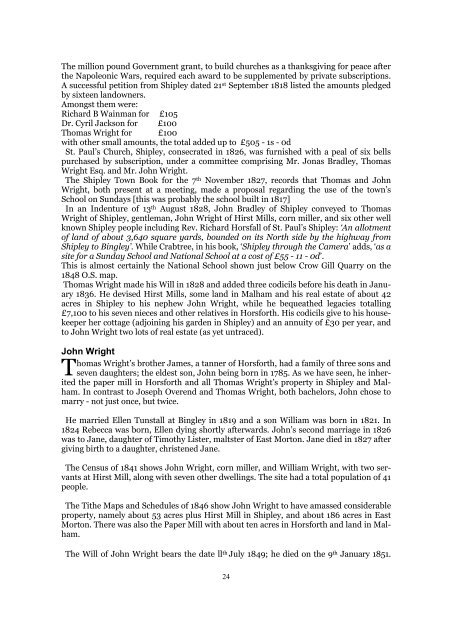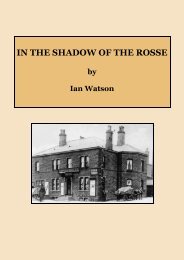Create successful ePaper yourself
Turn your PDF publications into a flip-book with our unique Google optimized e-Paper software.
The million pound Government grant, to build churches as a thanksgiving for peace after<br />
the Napoleonic Wars, required each award to be supplemented by private subscriptions.<br />
A successful petition from Shipley dated 21 st September 1818 listed the amounts pledged<br />
by sixteen landowners.<br />
Amongst them were:<br />
Richard B Wainman for £105<br />
Dr. Cyril Jackson for £100<br />
Thomas Wright for £100<br />
with other small amounts, the total added up to £505 - 1s - 0d<br />
St. Paul’s Church, Shipley, consecrated in 1826, was furnished with a peal of six bells<br />
purchased by subscription, under a committee comprising Mr. Jonas Bradley, Thomas<br />
Wright Esq. and Mr. John Wright.<br />
The Shipley Town Book for the 7 th November 1827, records that Thomas and John<br />
Wright, both present at a meeting, made a proposal regarding the use of the town’s<br />
School on Sundays [this was probably the school built in 1817]<br />
In an Indenture of 13 th August 1828, John Bradley of Shipley conveyed to Thomas<br />
Wright of Shipley, gentleman, John Wright of Hirst Mills, corn miller, and six other well<br />
known Shipley people including Rev. Richard Horsfall of St. Paul’s Shipley: ‘An allotment<br />
of land of about 3,640 square yards, bounded on its North side by the highway from<br />
Shipley to Bingley’. While Crabtree, in his book, ‘Shipley through the Camera’ adds, ‘as a<br />
site for a Sunday School and National School at a cost of £55 - 11 - 0d’.<br />
This is almost certainly the National School shown just below Crow Gill Quarry on the<br />
1848 O.S. map.<br />
Thomas Wright made his Will in 1828 and added three codicils before his death in January<br />
1836. He devised Hirst Mills, some land in Malham and his real estate of about 42<br />
acres in Shipley to his nephew John Wright, while he bequeathed legacies totalling<br />
£7,100 to his seven nieces and other relatives in Horsforth. His codicils give to his housekeeper<br />
her cottage (adjoining his garden in Shipley) and an annuity of £30 per year, and<br />
to John Wright two lots of real estate (as yet untraced).<br />
John Wright<br />
homas Wright’s brother James, a tanner of Horsforth, had a family of three sons and<br />
T seven daughters; the eldest son, John being born in 1785. As we have seen, he inherited<br />
the paper mill in Horsforth and all Thomas Wright’s property in Shipley and Malham.<br />
In contrast to Joseph Overend and Thomas Wright, both bachelors, John chose to<br />
marry - not just once, but twice.<br />
He married Ellen Tunstall at Bingley in 1819 and a son William was born in 1821. In<br />
1824 Rebecca was born, Ellen dying shortly afterwards. John’s second marriage in 1826<br />
was to Jane, daughter of Timothy Lister, maltster of East Morton. Jane died in 1827 after<br />
giving birth to a daughter, christened Jane.<br />
The Census of 1841 shows John Wright, corn miller, and William Wright, with two servants<br />
at Hirst Mill, along with seven other dwellings. The site had a total population of 41<br />
people.<br />
The Tithe Maps and Schedules of 1846 show John Wright to have amassed considerable<br />
property, namely about 53 acres plus Hirst Mill in Shipley, and about 186 acres in East<br />
Morton. There was also the Paper Mill with about ten acres in Horsforth and land in Malham.<br />
The Will of John Wright bears the date ll th July 1849; he died on the 9 th January 1851.<br />
24



